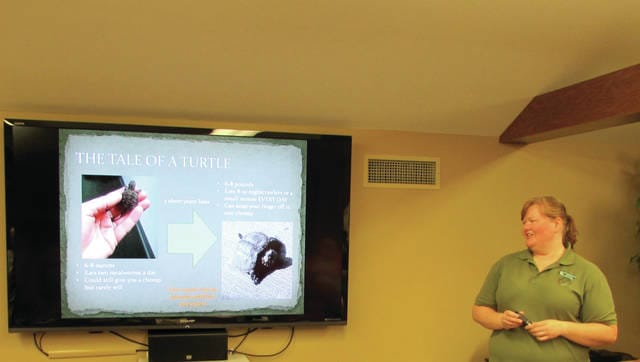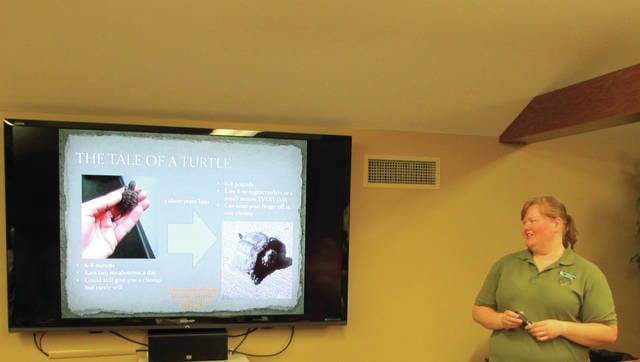

GREENVILLE – Darke County Park District Volunteer Coordinator/Naturalist Kathi McQueen presented “Injured and Orphaned Wildlife: What you Need to Know”, at the Greenville Public Library, April 19.
With the incoming Spring, folks are likely to see new baby critters running around outside. The information McQueen presented from the Ohio Department of Natural Resources Division of Wildlife and from her personal experience, some myths were put to rest about saving animals in the wild. The main message is that human intervention is always a wild animal’s last resort for survival; never its best hope.
“Most of the time wildlife should be observed and not moved or removed by humans,” McQueen said. “If you hold wildlife, be gentle and courteous and put it back. The forest, even your backyard, provides everything that animal needs, otherwise it wouldn’t be there. If it has a place to hide, food and water it is doing much better than you can do by taking it in your house.”
Salamanders, for example, need special lighting with bulbs that are $30 dollars a piece, according to McQueen. They also need special sand with calcium to get their calcium intake.
“You can put it in a carrier with a rock and a bowl of water, but it’s not going to live very long or live a happier life than it is already living out there in the forest or your backyard,” she said. “Plus, when animals reach sexual maturity, they start to become a danger because they want things you can’t give them. You can’t give them a girlfriend and space to roam and find territory.”
For those in doubt of whether or not an animal needs care, answer the following questions.
Is it bleeding or wounded? Is it covered in fly eggs? Has it been crying for more than one day? Does it appear weak and lying on its side? Was it attacked by a pet? If the answer is “yes” to any of these questions, contact the nearest permitted wildlife rehabilitation center for treatment (see link below). If the answers were no, leave the animal alone. Careful thought should be put into making decisions about whether or not animals need help, McQueen said. No animal may be retained for more than 180 days, at a wildlife rehabilitation center, without specific authorization from the wildlife officer, according to the Ohio Division of Wildlife.
“If they can’t release it because it is unable to live out in the wild as normal, then it becomes euthanized,” McQueen said. “There is a 50/50 chance of that animal being put to sleep, which to me that is really sad. I don’t want to make the wrong decision in taking an animal in and thinking that it needs care. All of them are not getting the care you think they are getting at the rehab centers.”
In addition, McQueen provided a myth buster, by addressing the following myths. If you touch a baby animal, the mother will reject or kill it – false; if you see an animal in the day, it has to be rabid – false; I found a baby bunny and the mother has not come back – kind of true. Baby bunnies that are unattended, usually are not unattended. Baby bunnies usually are left alone all day, so at night the mother comes and feed them once and leaves again, McQueen said.
People may think they are doing a good thing by taking in a baby animal. But once the animal is imprinted or socialized, that animal, especially if found as a baby, recognizes humans as someone they can trust, McQueen said. If the animal is later released, it becomes a nuisance and will be removed.
“Animals in the wild are not pets. Taming a young animal will make it unreleasable in the wild,” McQueen said.
For more information, visit wildohio.gov/staywild.





